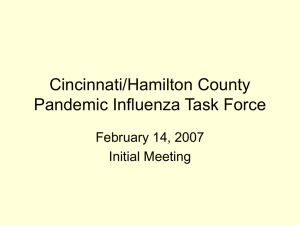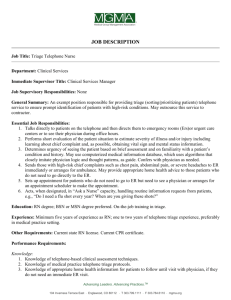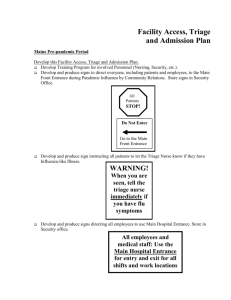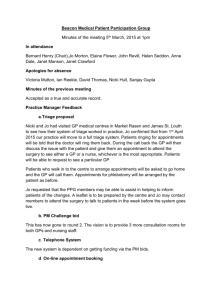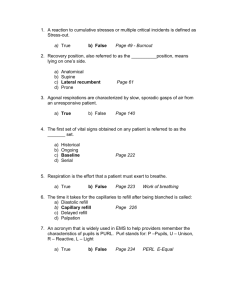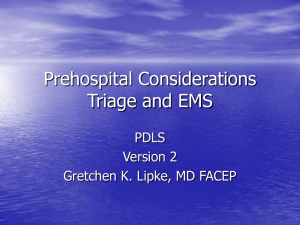Triage Guidelines
advertisement
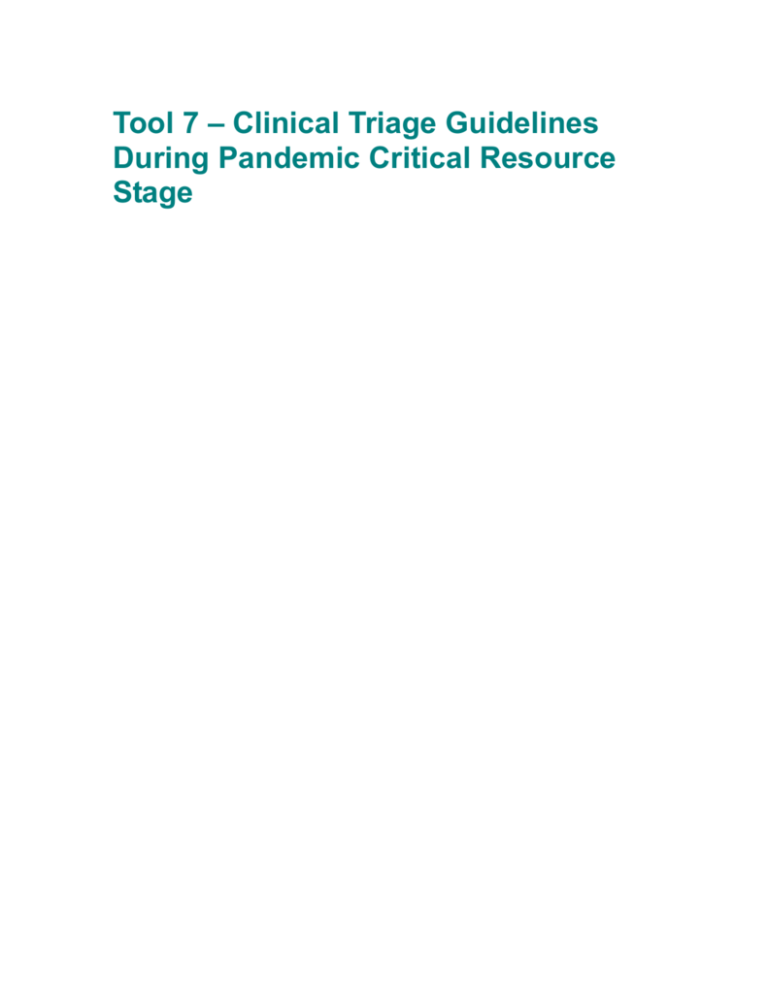
Tool 7 – Clinical Triage Guidelines During Pandemic Critical Resource Stage Draft 3/13/07 Clinical Triage Guidelines during Pandemic Critical Resources Stage Patients with Influenza symptoms1 Clinic/Urgent Care 911: EMS Public Health Information line Hospital triage center Pandemic flu triage protocol2 (1) Hospital admission - Medical beds - ICU beds Ventilators Critical care - X-ray, laboratory (3) (2) Influenza care center - Intermediate care IV & PO hydration IV & PO antibiotics Oxygen delivery - Board and care - Nursing services - MD on site/on call Home care - Oral hydration - Oral antibiotics - Antipyretics - PPE - Isolation Notes: 1. Influenza symptoms: High fever (T > 38) plus sore throat, cough or shortness of breath. Other symptoms: weakness, malaise, myalgias, chills, headache, nasal congestion, and (sometimes) abdominal symptoms. 2. Pandemic flu triage protocol must consider: Available resources: vital signs, examination, pulse oximetry Patient: wears respiratory mask on presentation Personnel: respiratory and universal precautions Evaluation: age, living conditions, functional status, sick contacts Other comorbid medical conditions 2 Draft 3/13/07 A. Adults and children >10 years of age AND > 25 kg (55 pounds): modified pneumonia severity index (PSI) calculation Characteristic Points assigned Highest risk age group(s) (to be determined) +10 Significant co-morbid illness1 +10 Physical exam Altered mental status +20 Respirations >30 +20 Systolic BP<90 +20 Pulse >125 +20 Room air pulse oximetry <92% +20 (1) Admission to hospital: Score > 50 or a. Toxic appearance or rapid decompensation (especially important in adolescents and in pregnant women) b. Significant hypoxia – O2 saturation in room air < 88% 1 For purposes of these triage guidelines, significant co-morbid illness would include any of the following: Pregnancy Asthma requiring daily use of medications, or symptomatic at presentation, Chronic lung disease, requiring oxygen or medications, or symptomatic at presentation, Hemodynamically significant congenital heart disease, Heart failure, HIV infection with CD4 count < 200, Patients on systemic steroid therapy equivalent to prednisone >15 mg/day for >1 month, Severe rheumatological or autoimmune diseases, Other immunocompromising conditions likely to result in life-threatening complications, Renal patients requiring dialysis, Cancer, currently on chemotherapy or radiation therapy, Severe anemia with hemoglobin concentration < 10 gm/dl, Hemoglobinopathies, such as sickle cell disease or thalassemia, Chronic neurological disorders affecting the muscles of respiration, such as spinal cord injuries, spastic quadriplegia, muscular dystrophy, etc. 3 Draft 3/13/07 (2) Admission to Influenza Care Center:2 a. Score > 50 and no hospital beds available, OR b. Score < 50 and needs closer monitoring and nursing care (for example, IV fluids, IV antibiotics, etc.), OR c. Score < 50 and unable to care for self or return if symptoms worsen. (3) Discharge to home: a. Score >50 with poor prognosis and unlikely to benefit from hospitalization, or b. Score < 50 and able to care for self or has caregiver, and able to return if symptoms worsen. B. Children under 10 yrs of age: Indications for hospital admission include any of the following a. Fever and age < 3 months b. Significant tachypnea c. Hypoxia on pulse oximetry d. Chest retractions, cyanosis, intermittent apnea, nasal flaring e. Toxic appearance The plan is currently pending for how to provide care to children who meet criteria for hospital admission when no pediatric hospital beds are available. 2 Persons with the following conditions can not be accommodated at an Influenza Care Center (due to staffing ratios, equipment, or supply limitations), regardless of their score: Age < 10 yrs Weight > 300 lbs (ICC cot weight limit is 300 lbs) Asthma exacerbation or other condition requiring respiratory support Congenital heart disease on oxygen Unstable angina Pregnant with condition requiring hospital care or within one week of due date Cirrhosis with ascites Chronic renal failure on dialysis Acute immunosuppressing condition (acute leukemia, s/p bone marrow transplant, etc) Sickle cell disease HIV with CD4 < 200 Mental status precluding care with minimal staffing (dementia, psychosis, delirium, suicidality, homocidality) Acute alcohol or drug withdrawal, or on methadone maintenance Severe mobility impairment (from neuromuscular disorder or otherwise) 4

